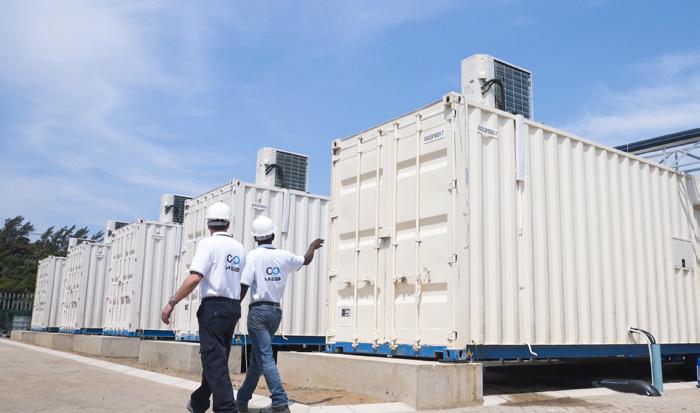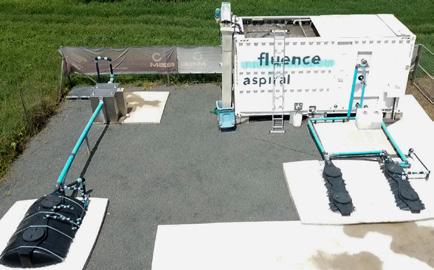
4 minute read
MABR in action
Fluence Corporation MABR (membrane aerated biofilm reactor) provides an improvement in aerobic wastewater treatment due to its highly efficient nutrient removal and its energy efficiency.
“During the process, oxygen is constantly supplied to the fixed nitrifying biofilm that develops on the wastewater side of the membrane while denitrification occurs in the anoxic bulk liquid. The unique MABR process provides highly efficient biological nutrient removal, resulting in operational savings and minimal footprint requirements that make decentralised treatment more feasible,” explains Lunga Patso, process engineer at MEB, the exclusive representative of Fluence Corporation in South Africa.
Advertisement
A conventional activated sludge (CAS) wastewater treatment process typically requires multiple chambers (anaerobic-anoxicaerobic), but MABR performs the actions in a single tank, since the membrane can achieve aerobic and anoxic conditions in the same chamber. This smaller footprint is especially useful in urban areas.
The MABR module is a spiral-wound sleeve of oxygen-permeable material. An air spacer inside the sleeve allows for low air pressure flow. There is also an external water spacer that controls the water volume that is in contact with the membrane.
It is submerged in the biological reactor where intermittent mixing from diffusers causes the wastewater to circulate through the spiral. A short mixing duration is sufficient to homogenise the contents of each stage of the spiral reactor. The aerobic biofilm develops on the surface of the membrane and its thickness is well controlled – it cannot grow beyond 300 microns.
Patso adds that it is important to note that the wastewater is not filtered through the membrane. “The membrane provides optimum conditions for biology in wastewater. Therefore, there is no membrane clogging and fouling, no need to replace membranes every few years and no need for regular chemical maintenance. This reduces the operating expenditure of the plant. The MABR module is constructed from durable materials, ensuring more than a 20-year life expectancy.”
MABRs can be used in package plants and as a retrofit in existing CAS/AxO wastewater treatment plants to increase capacity and/or improve effluent quality.
Pilot project
eThekwini Metropolitan Municipality is placing a greater emphasis on promoting innovation, technology transfer, as well as research and development. This has resulted in the signing of a memorandum of understanding between MEB and eThekwini Water and Sanitation with the aim to assist with improving water quality issues and accelerate the process of implementing new, more efficient wastewater technologies.
The first phase of the project started in 2020, where the Aspiral™ S1 System – a full packaged plant containing fine screening, one MABR module, aerobic volume, secondary clarifier, disinfection, and control cabinet in a 20 ft container – was installed in Phoenix, Durban.
Patso explains that MABR is not a new, untested technology. “Fluence is one of three global suppliers of MABR technology, and they have over 340 installations worldwide. MEB decided to showcase the technology in eThekwini, KwaZulu-Natal, South Africa, as a platform to demonstrate the effectiveness of MABR under local conditions. The aim of the pilot project is to treat wastewater to drinking water quality.
“Currently, the effluent produced can be used for irrigation purposes. In the second phase of the project, tertiary treatment processes will be added to produce drinking water that meet SANS 241:2015,” says Patso.
Due to the pre-packaged plant design and the limited amount of civil work needed (only concrete slabs), the entire system was installed within one week.
As a fully automated system, the Aspiral™ S1 can be accessed from any location. This feature proved valuable during the Covid-19 pandemic and when there was civil unrest in KwaZulu-Natal. The site could not be physically accessed for a period of two weeks, yet the system could be monitored, operated and optimised remotely.
Pre-treatment is done through coarse screening and grit removal systems. A fats, oils and grease (FOG) trap is only required for oily wastewater with FOG concentration higher than 60 mg/ℓ
Pre-treated wastewater is pumped from an equalisation tank through a perforated 1 mm fine pre- screening and flows into the Aspiral™ S1 system where a submerged MABR module will allow for simultaneous nitrification and denitrification processes, removing organic matter and total nitrogen pollutants from the wastewater.


“MEB is working with an independent, accredited laboratory that samples the treated effluent and provides results. As seen in the results shown in Table 1, the biofilm process protects from load shocks, low temperatures and even power disruptions,” states Patso.
The mixed liquor from the MABR stage flows into the secondary clarifier unit where it is separated into two streams: clean, high-quality effluent and sludge. Most of the produced sludge is recirculated back to the MABR process, while the rest is periodically discharged to the sludge holding tank.
Other benefits
MABR technology is extremely energy efficient due to its passive aeration. By using low air pressure, the bubbleless aeration system reduces energy consumption by up to 90% compared to conventional technologies. On average, 0.25 kWh of energy is consumed per cubic metre of wastewater treatment. This means that it can be operated with alternative energy sources, making it ideal for decentralised treatment.
“Its effective oxygen permeability leads to a high nitrification rate. Wastewater is treated to irrigation standards, BOD and nutrients are removed within a single tank, and this reduces the need for mixers required for the anoxic stage in the CAS process. The MABR module has fewer electromechanical components, making the entire system easy to operate,” states Patso.
MABR’s low odour and noise levels make the technology ‘neighbourhood friendly’. A side benefit of the MABR design is the ability to achieve up to 90% phosphorous removal without a dedicated anaerobic zone and chemical addition for this purpose. This drives down the operating expenditure on chemicals.
“MEB believes that everyone – regardless of their race, culture or background – has a right to access clean, safe and reliable water and we are proud of this pilot project that assists eThekwini Municipality to efficiently treat wastewater,” concludes Patso.









